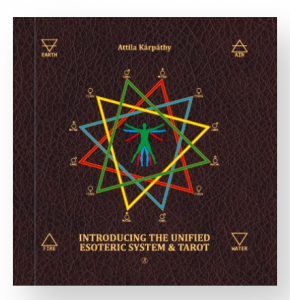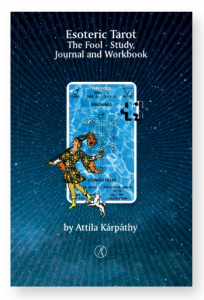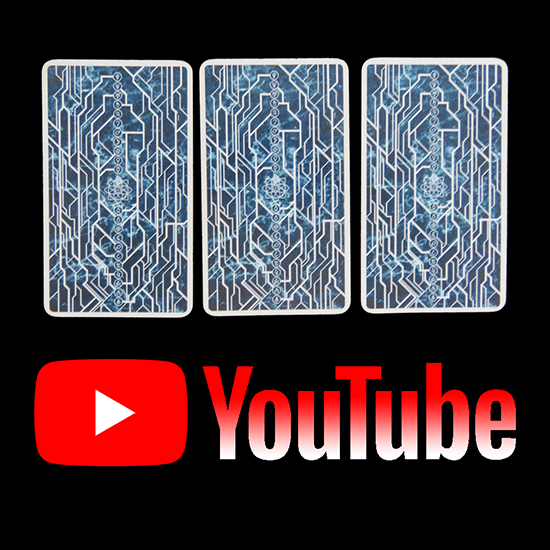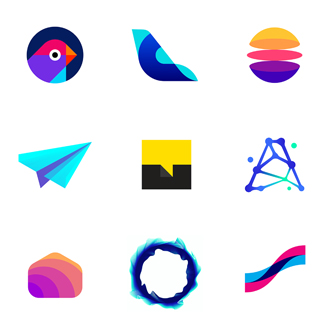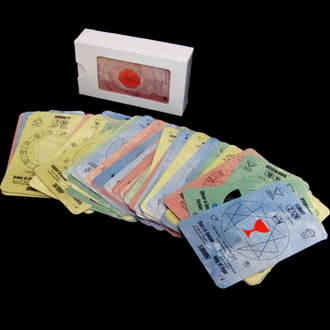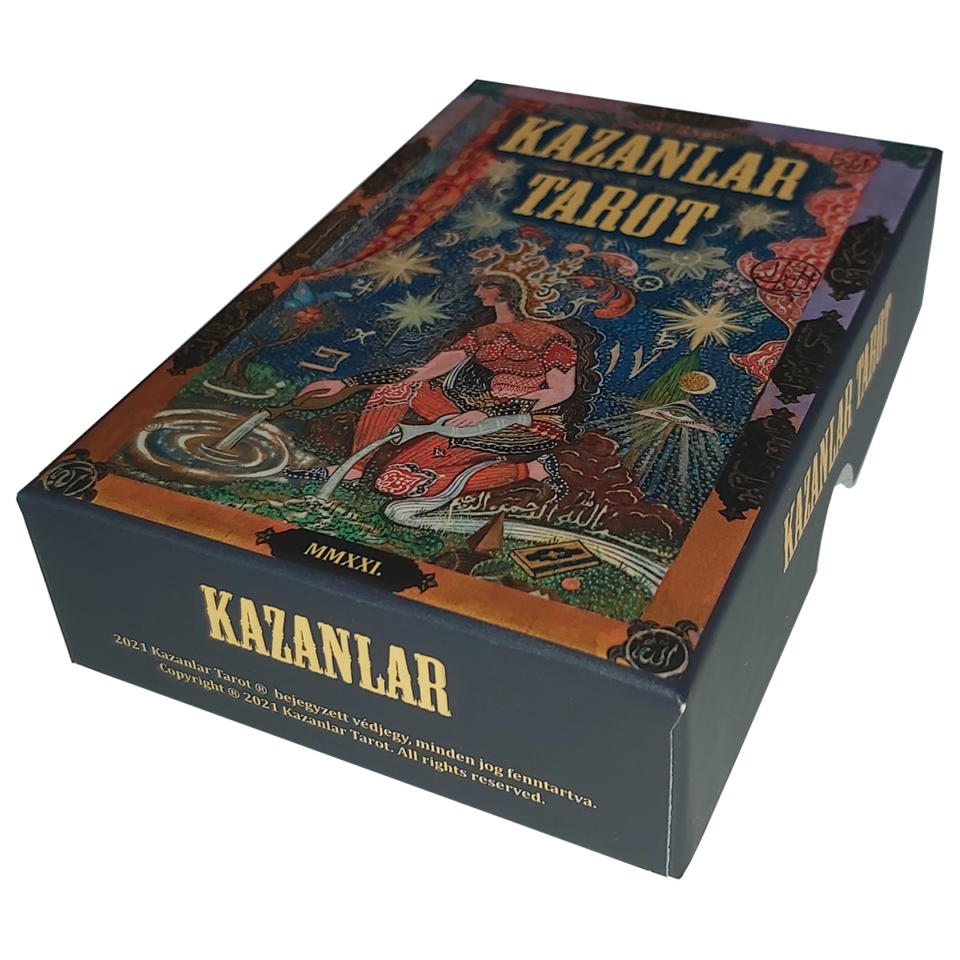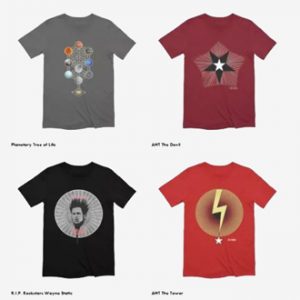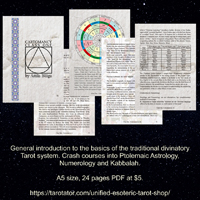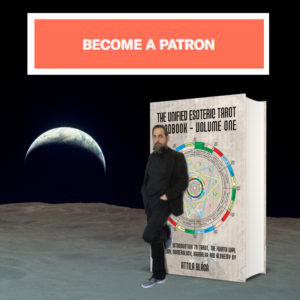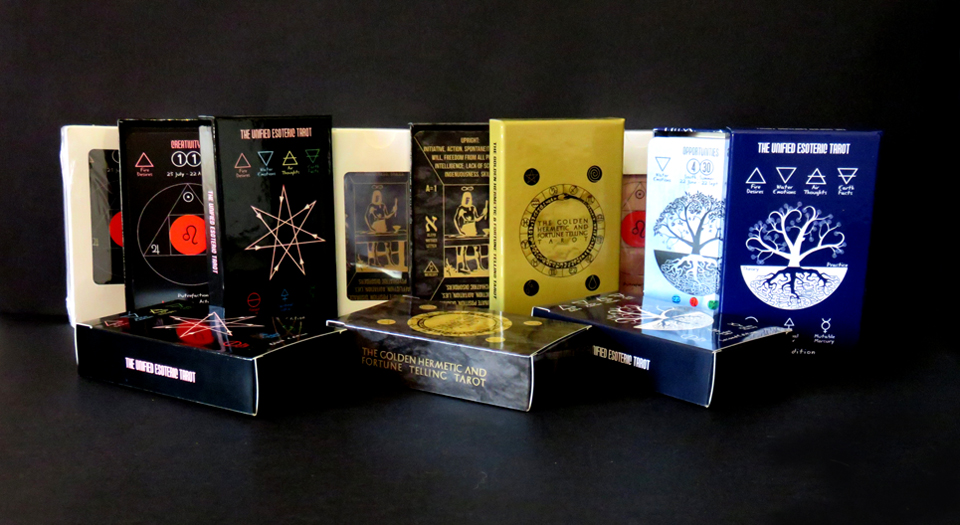
Tarot reader and card creator Case Kūjaku asked the same 7 question to 4 contemporary card creators: Ciro Marchetti, Doug Thornsjo, Gary Shook and Attila Blága.
Case has been into reading cards since the late 1970s, before mobile phones and the internet, back when people left their doors unlocked and wore horrible clothes. He started out reading playing cards because in those days in New Zealand it was pretty difficult to find tarot cards, plus his mother thought they were stupid and would have just thrown them out anyway.
When he went to university in the early 90s, Case got into tarot through getting interested in psychology and reading stuff by a human called Carl Jung and another human called Joseph Campbell. He was also really into the occult, and doing lots of silly dances and reading books and stuff.
Case turned professional in 2013 and people started giving him money to answer questions for them about whether their boyfriend’s were really homosexual, if they should change jobs, and what was going to happen in the future. In 2015 he made a tarot deck called Tarot Naught, and let his friends buy copies. Then he made a tarot deck that was pictures of all his friends, but nobody bought it. After that he made eleven more tarot decks, which people did buy.
Ciro Marchetti is an award-winning artist from the United Kingdom. He studied art in London, followed by a career working in Europe and South America before settling in the United States where he opened a branch of his design agency in Miami. In addition to managing his company, Ciro also gave workshops and lectures on digital imagery and illustration at the Fort Lauderdale Art Institute. In the mid nineties he sold his company and turned his back on the corporate design world to pursue his own visionary art.
Ciro has created a collection of popular Tarot, Oracle, Lenormand and Kipper based decks, including the extremely popular Gilded Tarot, and the Legacy of the Divine, both of which being often considered as quintessential additions to any serious tarot collection. I recently had a chance to interview him in regards to his views on tarot, and his thoughts on the subject follow.
Doug Thornsjo is a writer, cartoonist and graphic artist living with his two beloved pussyquats (Hunny and Whitey) in a tall old house filled with books, memorabilia, and, yes, tarot packs. His fiction has been published, among other places, in THE NORTH AMERICAN REVIEW and KINESIS, and has been broadcast on National Public Radio and nominated for the Pushcart Prize.
His first exposure to tarot, insofar as he remembers, happened during a performance of HAIR, when a cast member draped an enlargement of Pamela Colman Smith’s “Lovers” card over the bald head of the audience member seated in front of him.
Though his interest in tarot thus dates back something like fort-mumble-mumble years, the cards had to compete for his attentions with a host of other interests, including film, television, the stage, fiction, comic books and all manner of pop cultural diversions. It is only quite recently, with a solid body of graphic design experience behind him, that he felt emboldened to create his first Tarot pack, TAROT OF THE ZIRKUS MÄGI (pronounced “Maggie”). You might say that this was his Sally Field moment, and (emboldened by the mild success of that first venture) he has been inflicting himself and his demented conceptions upon the tarot community ever since. His confused nature even extends to his nom de plume, which changes only slightly less often than his moods.
Gary Shook has been working with the tarot for well over thirty years. He is a tarot professional, teacher, author, and deck creator. Gary would be the first to tell you that his artistic background is nowhere near as formal or accomplished as others in this series of interviews. He has no degrees in graphic design or art, but rather he is self taught.
Gary’s style has been described as “iconoclastic” in that each of the four decks he has created to date are unique in style and focus. He works with multiple software platforms to create his decks using a photo collage method. The images are then processed using a variety of techniques to create the art style of each deck.
When asked how he became interested in the tarot his reply would be “for all the wrong reasons”. His early interest in the tarot led to his spiritual path and he views both as an integral part of the other. Gary is a Wiccan elder and the founder of the Ecclasian Tradition.
Attila Blága is an occultist and tarot deck designer from Transylvania. He is a Tarotrolog, Tarot reader, cardmaker and artist. Attila started his Tarot journey with the Rider-Waite-Smith deck at the beginning of the ’90s. It was a box edition with Waite’s Pictorial Key included, but he was simultaneously also gifted with Aleister Crowley’s Book of Thoth.
Through a need for a reference guide, he then used Crowley’s book and Waite’s deck. Some would consider it quite a bizarre combination but looking back now he thinks it makes perfect sense. For Attila, the Tarot is the crossroad, the melting pot of all the other esoteric sciences.
The Tarot, Kabbalah, and Alchemy all share the common foundation of Astrology and Numerology. Attila believes that a student of tarot cannot learn and understand one without learning and understanding the others. Just like in the universe, everything is connected.
Attila started his studies into the occult with Tarot, and subsequently, Astrology, Numerology, Alchemy, Kabbalah, The Fourth Way and later on dived into Astronomy, Geometry, Physics, Astrophysics, Quantic Physics, History, Cosmology, Ethnology, Botany, Biology, Psychology and so on, one step leading to another; the journey to find answers resulting in each answer simply leading to more questions.
Question 1: – Do you believe that deck designers must know how to read tarot in order to create a working tarot deck?
Ciro Marchetti: – No I don’t believe a designer needs to be an actual reader to produce a viable working deck for others. Did Jules Verne actually travel 20,000 leagues under the sea. Did George Lucas actually travel to a galaxy far far away, did all the renaissance artists actually experience or believe in the religious biblical scenes they depicted. Do advertising directors believe in all the content and virtues of the products or services that go into their commercials. Do I read tarot? No. Could I if I really tried? Maybe. But do I consider it to be an essential qualification in order to produce a more authentic deck? No.
My approach was always to provide and make the best tools I could so that other could read with them. I like to use an analogy of a musical instrument, one that I can make that is capable of producing a beautiful sound…. but not by me, but instead by musicians who could play it. I think the question is best answered in a statistical way. I estimate sales of my decks to be around a million copies over 15 years. Even if you allow for those who after buying them decided they didn’t like the imagery, or couldn’t resonate of connect with them, who put them away never to be used again, or gave them away, that still leaves hundreds of thousands that were and are being used.
One can safely estimate from that the likelihood of it translating into to multiple millions of readings using decks designed by someone (in this case me) who don’t actual read. So while that may financial the case, I think I can substitute it by reading instead the mind set of a typical customer and how they might relate and respond to those images.
Doug Thornsjo: – Yes. Full stop.
The only exception would be if the artist was working with someone like Barbara Moore, a collaborator who could provide the needed knowledge and background and the overall guidance. Understand that knowing the rules does not necessarily equate with slavishly sticking to them. But as better people than I am have often noted, you have to know the rules in order to know how to break them effectively. And it needs to be added that the reverse is also true. I know of several train-wreck tarot decks made by folks with tarot knowledge but no art or design experience. Unless you’re making a deck just for your own use, you need both.
Gary Shook: – This is a complicated question with no simple answer. While there are artists who create decks with no ability to “read” or even know anything about the tarot they would out of necessity base those decks on others. While the ability to read the cards is certainly a plus what is more important is an understanding of the history and symbology used. To know what a card represents is just one part of understanding the tarot, as important is knowing what the symbology means and why it is in the card.
Attila Blága: – Please allow me to ask you this: if you have a toothache, you will ask your carpenter neighbour to deal with your problem, or you will appeal to the services of a qualified, well-prepared dentist? Commonly people believe that any card deck which has seventy-eight cards, a twenty-two cards major Arcana and four Minor Arcana cards, is a Tarot deck. However, this is not entirely accurate. There are a considerable number of Tarot-like Oracles out there, generally, considered or labelled as being Tarot decks. And don’t get me wrong, I have nothing against Oracles! I am only saying that not any Tarot-like deck is a Tarot deck. Practically, most of the so-called Tarot decks on the market are Oracles. Tarot is a complex science which requires study, hard work, discipline and dedication. In my opinion, both, deck creators and Tarot readers should have extended knowledge of the esoteric sciences, primarily of Astrology and Numerology, and genuine understanding of the Tarot in order to create decks, respectively to provide quality guidance to others.
Question 2: – There appears to be an increasing number of independent artists producing tarot decks these days, as evidenced from the number of decks on Kickstarter and Indegogo at any one time. What would be your advice to artists hoping to break into the tarot deck production scene?
Ciro Marchetti: – To be realistic, the wonderful unique idea that you might be convinced the tarot community will go nuts over is unlikely to be the case. While it’s been noted that the overall tarot market pie is growing, the number of slices it’s being divided into is also increasing and therefore each slice proportional thinner. When you seriously factor in your actual costs of production along with secondary time for incidentals such as shipping and administration, handling everything from PayPal to bubble wrap, plus of course the actual creation of the images, It does not often add up to a viable proposition.
The possibility, indeed the probability, of unsold decks taking up space in the garage forcing your car to remain parked outside is highly likely. Even the most wonderful new system and artwork still has to be marketed. And even when properly explained, with the hope that selling the deck to one of the publishers will be the answer, even that is not a secure safety net, the bigger publishers only accepts about 3% of all the proposals they receive.
Doug Thornsjo: – First, be very certain of your motivations and know why it is you’re embarking on this path. Be realistic about what you expect out of it. Second, never stop researching. Never stop studying. Never stop looking at other people’s work. Know what’s in the market. Third, if you aren’t certain that you’re going to **LOVE** the Process, with a capital P that rhymes with T, stop right there. It takes, CONSERVATIVELY, six months to a year — and longer — of steady work to create a tarot deck. Being realistic about your expectations of the finished project, if you aren’t absolutely certain that you will LOVE the Process, you’re not going to create anything that will benefit or interest anyone.
Gary Shook: – Well first off be realistic in what you hope to achieve. If you are hoping to make a lot of money then most likely your hopes will not be fulfilled. Deck production and sales are expensive and your profit margins slim, it will take some time for you to break even much less make a profit. Deck creation must be done out of a passion for the tarot and a need to express your artistic visions. Join as many FB tarot groups as you can and seek out the deck creators that post on them, generally they will respond and help you if you reach out to them. The group “Tarot Deck Creators” is a gold mine of information and help to the new deck creator. Get your work in the hands of reviewers, a good review will help you more than anything.
Attila Blága: – Tarot is not about the art or the aspect, but it is about its symbolical and esoteric content. We tend to buy and collect Tarot decks based on aesthetic criteria, and we neglect the matter of content and consistency.
Till the end of the 19th century, the beginning of the 20th century, there were only a handful of Tarot decks and a couple of cardmaker masters. The secrets of the cardmaking, respectively of the card reading was the apanage of the few, and it was directly transmitted from one generation to another. The Tarot was something esoteric, which means both exclusive and extraordinary. Starting from the 20th century and exploding in the 21st century, Tarot became a mass produced and commonly available product at the reach of everybody. I am not sure yet if this is a good or a bad thing. Tarot is a spiritual instrument, but it was turned into something commercial, respectively something material. It is an item and for many a collectable. Something extraordinary was transformed into something ordinary. Both, game and printing companies, respectively independent artist think of the Tarot as a business opportunity. People speak and debate regarding Tarot more in terms of costs and profit rather than as an instrument of knowledge and self-development. We tend to forget about its deeply and fundamentally spiritual nature, and we focus more on the visual and material aspects. The modern man is not a highly developed spiritual being but an easily manipulatable consumer. The spectacular technological development of the last centuries does not to be confused for spiritual development. Oddly, the higher technology contributed to the lesser spiritual development of the human being.
Question 3: The tarot scene, while growing exponentially in recent years, is still a niche market. Why then spend your time and energy on that market rather than something more lucrative?
Ciro Marchetti: – Why indeed. Well believe or not because it’s more satisfying. Receiving feedback email from a customer describing how your work has made a real impact to them as readers and that you are in tarot terms the next best thing since sliced bread is rather nice to hear. But of course its commonly counteracted by scathing comments and reviews that your work is basically cheesy, commercial eye candy, and shallow. I personally prefer the sliced bread. But overall it’s a positively rewarding balance.
Doug Thornsjo: – You make it sound as if I had a choice.
Gary Shook: – Since I am retired I really don’t have anything more lucrative as an option. Nothing I do which is connected with my spiritual path is done with a profit motivation and the tarot certainly is connected. I never charge for teaching, seldom charge for readings, and offer my products at reasonable prices to allow me to continue producing them. My work is done out of love and passion, not for money.
Attila Blága: – My sole goal is to learn and understand; I want to develop and share my discoveries and knowledge with other individuals willing to learn, understand and evolve. Learning never has an end, but it is a constant, day by day process. There is a fundamental difference between knowing and understanding. It is crucial to understand instead of memorising mechanically. The Tarot decks are not only instruments of prediction but vehicles of preservation and transmission of the esoteric knowledge.
Question 4: – There are many people in the tarot industry producing decks and writing about tarot. Do you have any thoughts on why some succeed commercially and some do not?
Ciro Marchetti: – Because some are quite poor and amateurish, it’s like visual karaoke. Your mom may think your rendition of Gloria Gaynor’s classic song lyrics “Once I was afraid, I was petrified” may be indistinguishable from the Mowtown original, but many others in the audience may not be-so impressed and will take the opportunity to go to the bar to fill their drinks.
Doug Thornsjo: – I think the answer to that is contained in my answers above. If you don’t know or trust tarot, if you don’t believe in it, if you don’t understand the basics of the symbolism and are unwilling to learn, you will fail. If you don’t have at least basic design skills, you will fail. If it’s just something you’re doing to make money — first of all, you’ll be disappointed, and second, you will fail. If you don’t love what you’re doing, you will fail. If you’re not interested in storytelling, you will fail. If you don’t have something to say (and it doesn’t have to be original, it just has to be REAL) —you will fail. On the other hand, if you’re in it because you love tarot, because you have a story to tell, because you have something to say, or because you want to reach out, in some way, to people who share your interests, you have a better chance of succeeding. But the odds are still stacked against you.
Gary Shook: – I would take exception to the use of the words “succeed commercially” being used. How well a deck sells does not define if it is a success. Is the creator happy with the deck? Do other people like the deck? These to me are more important definitions of success. There are a lot of decks out there and more being produced all the time, if you want your deck to be noticed a few things will help. First your work needs to be distinctive which will set it apart from the others. It needs to be more than just pretty pictures, while the deck does need to be visually attractive is needs substance to go with the beauty. The images need to convey the message of the card through symbology, this is very important to elevate your work above many others. Another important element is marketing, the world’s most perfect deck will not sell if people don’t know about it. Get your name and work “out there” and find creative ways to keep it in the public eye.
Attila Blága: – The key word here is ‘commercial.’ As I said, Tarot is something spiritual, although, in the last one hundred years it was intensively marked as a product and cultivated to be commercially exploited. For instance, people like fairy tales, they want to live a dream and truth is always ugly, reality hurts. This may explain why people like Doreen Virtue has success while somebody with a less idealised approach is considered less attractive and subsequently will be less popular and commercially successful. Like in case of any product, it is about selling a dream. If someone says that Tarot is easy to use and learning is not necessary because its intuition and imagination based, obviously that will favour the selling of Tarot products. If someone says that Tarot requires years of study and hard work, it is less attractive and makes Tarot harder to sell. However, we should be capable of understanding the difference between something commercially successful and something valuable. Something commercially successful is not necessarily valuable, and something valuable is not always commercially successful. To succeed someone need to find the proper balance between being commercially attractive and having a genuinely valuable product.
Question 5: – How much of your work is taken directly from existing traditions, how much is borrowed and further developed (albeit augmented or modified), and how much is self derived or original?
Ciro Marchetti: – It’s a mix of all three. I stick to recognizable tradition so that the card’s basic concepts can be related to, but I don’t agree with all the meaning accredited to those early decks as being correct. Or that the images themselves are clear in their intent. I think many details and conclusions are reached via assumptions of historical, social, religious values of the time, with a sprinkling of subjective occult overtones introduced after the fact. I also have no interest in faithfully cloning or recoloring images that have been produced in a multitude of ways already.
Doug Thornsjo: – I don’t delude myself that I’ve created anything new or original. If I have any talent at all, it’s for making connections and processing symbols in slightly different ways.
Gary Shook: – I suppose the answer to this depends on how you define traditions. If you’re talking about a pagan or wiccan style of tradition then not at all. While my world view is influenced by my wiccan tradition it does not define my decks. If you refer to an existing tarot tradition such as the Rider Waite, then my work is based 100% in it. All my decks are firmly grounded in the RWS symbolic language. The strength of my work is looking at that language in a new and unique way.
Attila Blága: – It is not that simple. Life and knowledge are like a building. You need a healthy foundation to built upon it. More you know, more you understand and further can develop. When you know a little you think you know everything; when you know a little bit more, you realise that you do not know a thing and you will always have to learn more. I think someone has to understand the tradition first fully and only from there someone can find its own path of development. That is true if we speak strictly about Tarot. Once again, Oracles are an entirely different story!
Question 6: – What are misconceptions, misunderstandings, and/or stigmas you would like to address and see cleared up in regards to tarot?
Ciro Marchetti: – Just because they did it five hundred years ago doesn’t make right . True tarot has been redefined too often, and has gone through any number of interpretations for there to be some as yet undiscovered definitive original with companion LWB.
Doug Thornsjo: – I have a very good friend in the comic-book business who happens to be a devout Christian, and although he’s never said anything to me about it, I’m pretty well certain that he believes I’m doing The Devil’s Work. And I wish I could clear that up, with him and others like him. It’s not about Heaven and Hell, there is nothing Satanic about Tarot. Tarot is a Tool. Use it right, and it will make you a better person. Use it improperly and you get the spiritual version of smashing your thumb with a hammer. It’s not the hammer’s fault that you smashed your thumb. Self-delusion is the real danger, but it’s a danger that runs throughout everything in life. It’s true that you can damage your life by misreading the tarot, but you can also get yourself killed if you don’t know that Red means Stop. Annnnd…. I think that’s a red light I see up ahead.
Gary Shook: – There will always be misconceptions with the tarot in that a large percentage of the population think it’s a work of the Devil and you are going to hell for reading the cards. What bothers me more is the tribalism that shows up with discussing controversial aspects of the tarot. Just post this simple question on any tarot group “should I use reversals in my readings?” then sit back and watch the flame war. The real and only answer is “whatever works for you” but people are so entrenched with their personal perspectives they get very defensive when someone questions their perceptions.
Attila Blága: – There are too many, but there is one I would like to address. Many authors claim that the Tarot has no esoteric origin because it is a further development of the ordinary deck of playing cards by the addition of the extra, twenty-two cards Major Arcana. First of all, not only the Major Arcana was added to the deck of playing cards, but also one extra court card. It is at least odd to add twenty-six cards. On the other hand, the architecture of the deck of the playing cards is profoundly esoteric. The four Suits represents the four seasons. The four Aces represents the four major astronomical events of the year, the two solstices and the two equinoxes. The thirty-six numerals represent the thirty-six decans of the Zodiac while the twelve court cards represent the twelve months of the year, respectively the Zodiac signs. No speculations, but pretty much basic Astrology. But sure, some still may claim, it is merely a string of coincidences.
Question 7: – What’s next for you in regards to tarot as a whole? Do you have anything in the works that you’d like to discuss?
Ciro Marchetti: – No more decks, I’m tired and somewhat burned out. It takes me some nine months and many headaches to produce a deck in my style and its likely that my time and style has probably had its day. There are simply just too many decks, with suites, elements and other deviation from the norm being produced in the hundreds each year and in what seems ever shorter amounts of time. Often using a combination of Google searches of source imagery and then the application of photoshop filters. The results are often rather cheesy, but several also quite interesting it must be said and they clearly have their appeal. But for me it kind of cuts into the time and dedication and the idea I was producing something special.
Maybe that was an over romantic assumption on my part, but the magic and the motivation that used to drive me is now questionable. Without it I don’t feel I could do justice to another project. To produce another deck I have to believe it would be better than the one before. In all honesty I don’t feel I can do that any more. But with that said I do have plans for various tarot related projects. From pop up books of the Fools Journey, to a series of behind the scenes animated YouTube videos explaining my personal process and explanations behind many of my favorite cards.
Doug Thornsjo: – Oh my goodness gracious yes. I am nowhere near done. I am bursting with ideas and if the Tarot community will continue to tolerate me, I will be around for a long while to come. Most of what I’m thinking about is in too early stages to discuss, BUT, I’ve got a Kickstarter coming right up at the end of December for my full-on Gothic deck (CROOKED WAY TAROT), and I’m actively working on a Dada Tarot and a Zirkus Mägi Kipper, both of which have pages already up at my website… which is www.tarotbyducksoup.com. Thank you for asking me to participate in this, and I hope to see you in the cards!
Gary Shook: – I have a few things in the works at the moment. I am working on a book to go with my Pastel Tarot that I hope to have done in a few months. I am also working with a well known YouTube reviewer on a new deck that will be a collaborative effort between us. Work on this is at a tentative stage at the moment but I have high hopes for the project.
As an ongoing endeavor I run a tarot meetup on Meetup.com. You can find the meetup here: https://www.meetup.com/Inland-Empire-Tarot-Group/
And as always I am busy with my Etsy store which is here: https://www.etsy.com/shop/Tarottica
Attila Blága: – I have self-published two Tarot deck this year, and I have created four more. Probably I will publish some of these, and I have in my mind a few ideas for several other decks. However, next year I would like to focus on publishing one way or another some of my books. The decks and the books are equally important and complementary components one to another.
Thank you very much for this opportunity!


